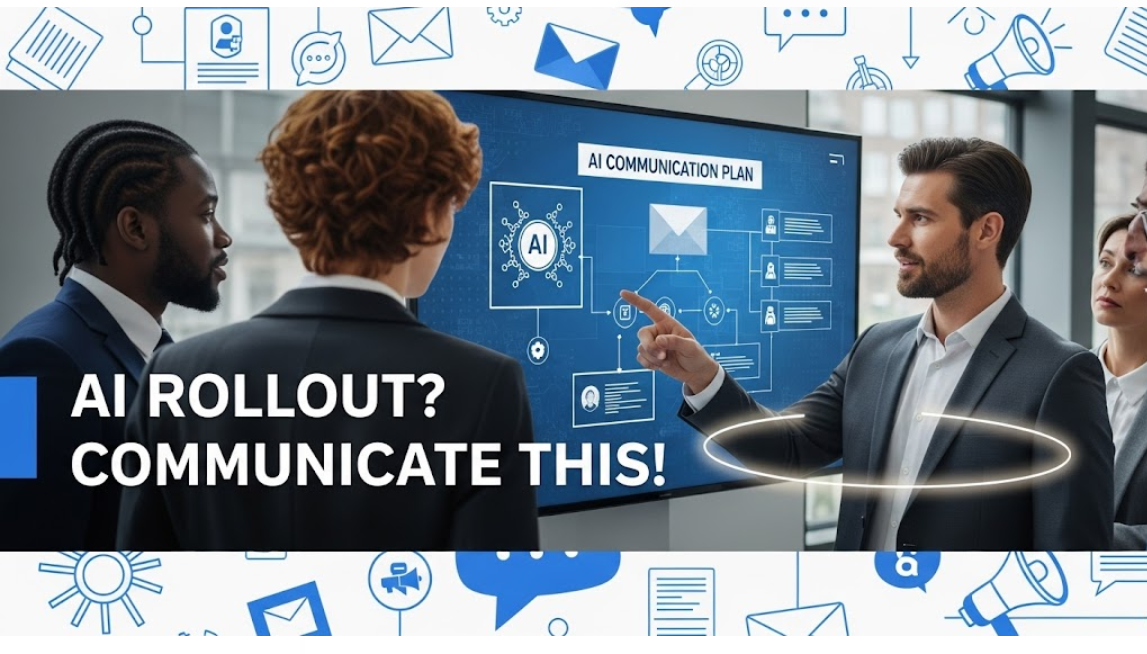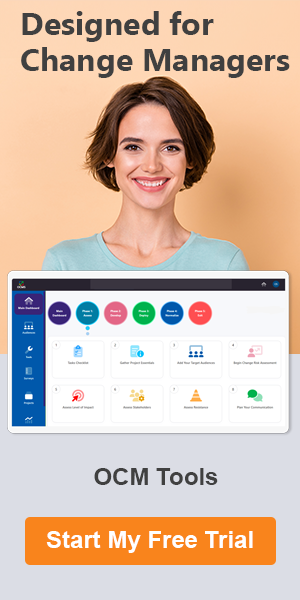Best AI Communication Strategy Guide.
Everything You Need to Know to Roll Out AI With Confidence
In this comprehensive AI organizational change management (OCM) guide, we’ll show you a best AI communication strategy that you can use to communicate AI rollout, get buy-in from stakeholders, reduce resistance from impacted users, and set your organization up for long-term AI adoption success.
You’ll discover practical AI communication strategies, actionable steps, and invaluable insights to confidently lead your team through the evolving landscape of artificial intelligence.
Let’s get started
Watch this overview video or read the guide below.
If you’re introducing AI into your organization, whether it’s through Copilot, ChatGPT, or any other AI solution, this article is for you. You’ll learn how to implement an AI communication strategy from the ground up, with real-life messaging tips, templates, and phases that walk your team through awareness to adoption.
📥And don’t miss the free downloadable AI Communications Plan Checklist at the end of this article to help you implement every phase step-by-step.
Let’s dive in
Ogbe Airiodion | Change Management Consultant, OCM Lead, Change Coach | Strategic & Tactical Change Management Implementation

Table of Contents
- How Communication Makes or Breaks Your AI Solution Rollout
- Understanding Your AI Communication Strategy
- Pre-Launch: Building Your AI Implementation Communication Plan
- Launch Phase: AI Rollout Messaging That Works
- Additional Strategies for Implementing AI – Your Detailed Communication Plan
- Post-Launch: Reinforcement and Real AI Adoption
- Managing Change and Driving Adoption with Communication
- Download Your Free AI Communications Plan Checklist, AI Change Plan, and More
- Conclusion: Lead AI Adoption with Clarity
- Frequently Asked Questions
Pro Tip: Think of each section of your AI rollout as a mini-campaign. Tailor your messaging to match the mindset of your audience at that stage.
How Communication Makes or Breaks Your AI Solution Rollout
Think of Alex, an experienced team lead whose team was about to implement a new AI-powered solution to boost productivity across the organization, but the response from employees was lukewarm.
There was fear of job loss from AI and a general lack of understanding about what the AI actually meant for their daily tasks. Confusion reigned. The problem wasn’t the AI tool, it was the lack of a communication plan.
Alex struggled to find clear, actionable guidance on how to address these concerns effectively. He knew a simple email wouldn’t cut it; he needed a real AI communication strategy that built trust and excitement, not fear.
Once Alex was able to implement the best AI communication strategies that we are about to go over, engagement skyrocketed, resistance decreased and employees began using the AI.
Pro Tip: Before launching any AI tool, map out your communication touchpoints across awareness, engagement, and reinforcement to avoid confusion and ensure alignment.
Understanding Your AI Communication Strategy
This section focuses on the overarching AI communication strategy that will guide all your efforts. It’s about setting the stage, defining your message, and understanding the broad impact of AI in your organization. Getting this right is the cornerstone of successful AI integration.
What is an AI Communication Strategy?
An AI communication strategy is a structured plan to help employees understand what the AI tool is, why it matters, and how it benefits them. It ensures leaders are aligned, managers feel confident, and end users are empowered. An AI communication strategy is more than just sending a few emails. It’s about building a narrative, fostering understanding, and preparing your entire organization for the inevitable changes AI will bring.
This foundational work ensures everyone, from leadership to front-line employees, grasps the why behind AI adoption. It’s about creating a coherent message that resonates, whether you’re discussing a new generative AI tool or an automated customer service system.
Your strategy needs to be adaptable, recognizing that communicating AI in the workplace is an ongoing process, not a one-time event. Start by identifying your key stakeholders, understanding their current perceptions (and misconceptions) about AI, and then crafting core messages that address these directly.
Effective communicating AI in the workplace involves three key things:
- Clarity
- Consistency
- Credibility
You need to provide consistent messaging, delivered through credible leaders or influencers in your organization. And don’t forget the “why”, your change communication strategy for AI should connect the AI tool to your broader company mission or business objectives.
Pro Tip: Use pulse surveys early on to assess employee sentiment before launching AI communications, this will inform your tone and channel strategy.

Pre-Launch: Building Your AI Implementation Communication Plan
Before any AI tool hits employees’ screens, your AI implementation communication plan should already be active. This includes pre-launch messaging, internal town halls, FAQs, and readiness campaigns. A solid AI change management plan should prepare employees not just for what’s changing, but for how it affects them. You’re not just launching a tool, you’re launching a mindset shift.
Wondering how to communicate AI changes to employees? The answer: Make it relevant. Speak to how AI impacts their role, not in technical terms, but in daily outcomes, like saving time, eliminating repetitive tasks, or improving decision-making.
Here are the actionable steps to build your robust pre-launch communication strategy:
Step 1: Understand the “Why” and “What” for Each Group
Before you even draft a single message, clearly define the purpose of the AI tool and its specific impact on different departments or roles. A sales team using AI for lead generation will have different concerns and benefits than a customer service team using AI for automated responses.
- Actionable Step: Conduct internal interviews with department heads, managers, and a sample of employees from various teams to understand their current workflows, potential pain points, and existing perceptions (and misconceptions) about AI. This direct input will tailor your messages.
Step 2: Craft Your Core Message and Key Benefits
Based on your understanding, develop a clear, concise, and consistent core message. This message should highlight the strategic reason for AI adoption (e.g., enhancing efficiency, improving customer experience, fostering innovation) and articulate the tangible benefits for employees. Avoid jargon.
- Actionable Step: Create 3-5 key talking points for each major stakeholder group (e.g., leadership, managers, frontline employees) that focus on their benefits and how AI will make their jobs better, not just different.
Step 3: Develop a Multi-Channel Communication Roadmap
Don’t rely on a single email. A robust pre-launch plan uses a mix of channels to ensure your message is heard and understood.
- Actionable Step:
- Leadership Message: Have a senior leader issue a high-level announcement (e.g., video message, company-wide email) explaining the strategic vision for AI.
- Departmental Briefings: Equip managers with specific talking points and resources to lead discussions in team meetings.
- Internal FAQs: Develop a living document of frequently asked questions, updated regularly based on employee inquiries.
- “Sneak Peek” Sessions: Host optional, informal “lunch and learn” sessions or virtual demos showcasing the AI tool’s capabilities and its positive impact on real-world tasks.
- Intranet Hub: Create a dedicated section on your internal intranet for all AI-related communications, resources, and updates.
Step 4: Address Fears and Misconceptions Head-On
Ignoring concerns about job security or skill obsolescence will breed mistrust. Proactively acknowledge these fears and provide clear counter-arguments and support plans.
- Actionable Step:
- Transparency: Clearly state how AI will (or won’t) impact roles. If roles are changing, explain the plan for reskilling or upskilling.
- Success Stories: Share internal or external AI adoption communication examples where AI has augmented human capabilities rather than replaced them.
- Dedicated Q&A Sessions: Hold open forums, town halls, or “ask me anything” sessions with project leaders and HR to address concerns directly.
Step 5: Identify and Empower AI Champions
Recruiting internal champions is one of the most powerful strategies. These are respected employees who are enthusiastic about AI and willing to advocate for its adoption.
- Actionable Step:
- Identify: Look for early adopters, tech-savvy individuals, or influential team members across different departments.
- Train & Arm: Provide champions with in-depth knowledge of the AI tool, talking points, and answers to common questions. They can participate in pilot programs and share their positive experiences.
- Empower: Encourage champions to lead peer-to-peer discussions, offer informal support, and provide feedback to the core implementation team.
Pro Tip: Recruit champions early and arm them with talk tracks to support peer-to-peer influence and reduce resistance during early stages.
Launch Phase: AI Rollout Messaging That Works
The launch is your moment to shine!
Your AI rollout communication plan should be direct, energizing, and highly visible. This is the time for cross-channel communications that create excitement and provide clear next steps. It’s about making the new AI tool feel accessible and beneficial from day one.
Using an AI project communication template is essential during this phase to standardize messaging across departments. Whether you’re announcing access to a new AI assistant like Copilot or launching AI chat features in customer service, a consistent template ensures no team is left behind and everyone receives accurate, unified information. Highlight key benefits and give people a clear first step: where to access the tool, how to get help, and what success looks like.
Here are the actionable steps to execute a compelling launch phase communication plan:
Step 1: Orchestrate a Multi-Channel Launch Blitz
Maximize visibility and excitement by hitting multiple communication channels simultaneously. This creates a buzz and ensures key information is hard to miss.
- Actionable Step:
- Company-Wide Announcement: Send a personalized email from a senior leader on launch day, announcing availability and reiterating key benefits.
- Intranet Takeover: Feature banners, pop-ups, and a dedicated AI hub on your internal intranet with all relevant links, FAQs, and training materials.
- “How-To” Videos: Create short, engaging videos demonstrating the AI tool’s core functions and how it solves common problems.
- Live Demos & Q&A: Host interactive virtual or in-person sessions where employees can see the AI in action and ask live questions. Record these for later viewing.
Step 2: Provide Clear “First Steps” and Accessibility Info
Don’t just launch the tool; launch a clear path to using it. Confusion on how to start is a major barrier to adoption.
- Actionable Step:
- Direct Links: In all communications, provide direct, easy-to-find links to the AI tool or platform.
- “Get Started” Guides: Create simple, visual guides that outline the first 3-5 steps an employee should take to use the AI tool.
- Support Channels: Clearly communicate where employees can go for help (e.g., dedicated support email, internal IT helpdesk, community forum).
Step 3: Highlight Immediate, Tangible Benefits (The “WIIFM”)
Focus on the “What’s In It For Me” (WIIFM) for the employee. How will this AI make their job easier, faster, or more enjoyable right now?
- Actionable Step:
- Scenario-Based Messaging: Instead of listing features, present scenarios: “Now you can [achieve this benefit] by [using this AI feature], saving you [X amount of time/effort].”
- Quick Wins: Identify and promote specific tasks or pain points that the AI can immediately alleviate for users.
- Success Stories (Pre-populated): If possible, share early internal pilot success stories or quick wins from your champions.
Step 4: Empower Managers as Frontline Communicators
Managers are key to successful adoption. They are the most trusted source of information for their teams.
- Actionable Step:
- Manager Briefing: Hold a dedicated pre-launch briefing for all managers, providing them with the launch messaging, updated FAQs, and specific instructions on how to support their teams.
- Team Meeting Prompts: Give managers ready-to-use discussion prompts or slides for their team meetings on launch day or shortly after.
Step 5: Send a “What You Can Do Today” Message
This message acts as an immediate call to action and guides employees to their first successful interaction with the AI.
- Actionable Step: On launch day, send a concise message (email or internal chat) outlining 1-3 very easy, low-risk tasks for employees to try with the new AI tool. For example: “Try asking Copilot to summarize your last meeting notes,” or “Use the new AI chat to find quick answers in the knowledge base.”
Pro Tip: Send a “What You Can Do Today” message on launch day that includes three easy tasks to get started using AI.
Additional Strategies for Implementing AI – Your Detailed Communication Plan
This section dives into the practical aspects of putting your strategy into action. It specifically addresses the AI implementation communication plan, providing a structured approach for informing and engaging employees as new AI systems are introduced. This is where the rubber meets the road, and clear communication is paramount to avoid confusion and resistance.
Developing a robust AI implementation communication plan is crucial for minimizing disruption and maximizing buy-in. This plan outlines exactly how to communicate AI changes to employees at every stage of the implementation. It’s not enough to simply announce a new system; you need to explain what it is, how it works, why it’s being introduced, and most importantly, how it will impact daily roles and responsibilities.
This requires foresight and a detailed schedule of communications, from initial announcements to training schedules and post-launch support.
Your AI rollout communication plan should break down complex technical information into digestible, relevant pieces, ensuring that employees understand their role in the new AI landscape.
Think about the channels you’ll use – town halls, internal memos, dedicated intranet pages, or even informal team discussions – to ensure your message reaches everyone effectively.
Post-Launch: Reinforcement and Real AI Adoption
Post-launch is where your employee communication plan for AI adoption really matters. The goal is to prevent drop-off and build sustainable habits.
Keep momentum going by sharing AI adoption communication examples like success stories, spotlight users, and productivity metrics. Reinforce the message that AI isn’t optional, it’s essential. Celebrate quick wins and normalize AI usage by integrating it into performance reviews, team meetings, and day-to-day workflows.
Pro Tip: Create a recurring “AI Highlights” newsletter showcasing how employees are using the tool and saving time.
Managing Change and Driving Adoption with Communication
This section addresses the human element of AI integration, focusing on the AI change management plan and the vital employee communication plan for AI adoption. It’s about proactively addressing concerns, building confidence, and ensuring your team not only accepts but embraces AI as a tool for success.
Successfully navigating the introduction of AI requires a thoughtful AI change management plan that is deeply intertwined with your communication efforts. This plan recognizes that change can be unsettling and aims to mitigate resistance by addressing fears head-on and empowering employees.
Your employee communication plan for AI adoption is the engine of this change management, providing clear, consistent, and empathetic messages. It’s about demonstrating how AI will enhance, rather than diminish, employee capabilities, creating new opportunities, and streamlining processes. Sharing AI adoption communication examples can be incredibly effective here, showing real-world scenarios or testimonials of successful integration.
This builds confidence and provides tangible proof of AI’s benefits. The overarching change communication strategy for AI should foster an environment of learning and adaptability, positioning AI as an evolutionary step that benefits both the individual and the organization.
Pro Tip: Create feedback loops! Provide avenues for employees to voice concerns, ask questions, and share their experiences with AI. This not only builds trust but also provides valuable insights for refining your communication strategy.
Download Your Free AI Communications Plan Checklist & Implementation Plan
To make your rollout easier, we’ve created free resources: A step-by-step AI Communications Checklist covering your full journey from awareness to adoption, a downloadable AI Communication Roadmap & Implementation Plan to help you align messaging, timing, and ownership, and more.
✅ Included in these resources:
- Pre-launch AI communication messaging steps
- Sample AI communication messaging themes by rollout phase
- Targeted AI audience and channel alignment tips
- Success AI change management metrics you should be tracking
📥 Download the Following Here
- AI Communications Plan Checklist
- AI Change Communication Plan and Roadmap
- AI Change Communication Strategy – Change Management Implementation Plan
Use these AI change management rollout tools to align your team, build momentum, and keep your communications plan on track.
Pro Tip: Personalize the AI comms checklist with your organization’s milestones and share it with AI project sponsors and AI champions to drive visibility and accountability.
Conclusion: Lead AI Adoption with Clarity
AI success isn’t just about the technology, it’s about how clearly and consistently you communicate it. By building a thoughtful, structured communication strategy, you’ll drive adoption, reduce resistance, and unlock real business impact.
So whether you’re launching Microsoft 365 Copilot, ChatGPT Enterprise, or another AI platform, don’t leave communication to chance. Start planning, build your message, and guide your people through every phase of change.
Pro Tip: Communication is the foundation for trust in any transformation, when in doubt, over-communicate.
Frequently Asked Questions (FAQs) – AI Communications Strategy
What is an AI communication strategy?
An AI communication strategy is a structured plan to help stakeholders understand, accept, and adopt artificial intelligence tools within the workplace. It includes messaging, timing, delivery channels, and audience alignment.
How do I communicate AI changes to employees?
Communicate AI changes by focusing on relevance, clarity, and transparency. Tailor your message to how AI will help employees in their roles, address concerns honestly, and offer hands-on support.
What should be in an AI rollout communication plan?
An AI rollout communication plan should include announcement emails, executive messaging, training invitations, FAQs, and live events. It should clearly outline the timeline, benefits, and how employees can start using the tool.
Why is communication important in AI implementation?
Communication is crucial because it helps build trust, reduce fear, and drive adoption. Clear messaging bridges the gap between leadership’s vision and employee execution.
What are examples of AI adoption communication?
Examples include employee spotlights showing successful use of AI, leader-endorsed video messages, productivity metrics post-launch, and regular newsletters with use-case stories.
What is the most important element of an effective AI communication plan?
The most important element is transparency and empathy. Leaders must openly communicate the why behind AI adoption, addressing employee concerns honestly while highlighting how AI will augment roles, create new opportunities, and benefit the organization as a whole.
How can we measure the success of our AI communication strategy?
Success can be measured through various indicators, including employee feedback surveys on understanding and sentiment, participation rates in AI training programs, reductions in resistance to change, and ultimately, the smooth and effective adoption of AI technologies within the organization.
Pro Tip: Save time by repurposing FAQs, success stories, and video messages into toolkits that managers can use in team meetings.
Note: Content on OCM Solution's ocmsolution.com website is protected by copyright. Should you have any questions or comments regarding this OCM Solutions page, please reach out to Ogbe Airiodion (Change Management Lead) or the OCM Solutions Team today.






